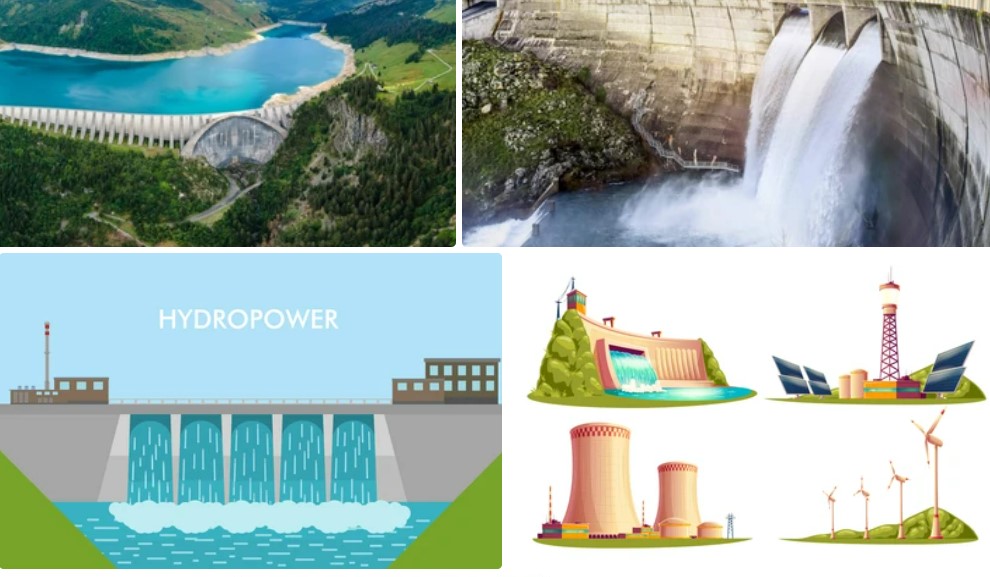Historically, in ancient civilizations, effective water conservation was of paramount importance, and this vital goal was achieved through the meticulous construction of highly advanced hydraulic structures.
Intricate structures: sturdy stone rubble dams, expansive reservoirs or lakes, well-engineered embankments, and precisely designed irrigation canals--all significantly contributed to efficient water management.
In contemporary India, this venerable practice persists where massive dams have been strategically constructed across numerous river basins; consequently ensuring the optimal utilization of valuable water resources.
Dams--What Are They and Their Role in Water Resource Management
Dams, often impressively constructed, represent magnificent barriers, strategically restricting the natural, swift flow of river water and consequently yielding reservoirs, tranquil lakes, or expansive impoundments. Serving numerous critical purposes within human society, dams ingeniously obstruct persistent currents of water in rivers, ultimately facilitating the creation of sizeable reservoirs or serene lakes.
Primarily functioning as obstructions, dams meticulously prevent uninhibited flows of river water, resulting frequently in the formation of vast reservoirs and picturesque lakes.
Evaluating Dams: Advantages and Disadvantages Explored
Dams, acting as essential infrastructures, skillfully address multiple necessary functionalities. Not surprisingly, dams, serving as vital infrastructures, are expertly built for a wide range of significant purposes, described below:
1. Irrigation: The primary rationale behind erecting sturdy dams is seizing water from turbulent rivers and torrential rain so that it is readily available to nourish expansive agricultural fields during harsh dry periods, thus ensuring a steady water source for crop sustenance.
The principal impetus for devising impenetrable dams hinges on the potential to judiciously detain water from sinuous rivers and ceaseless rainfall. This consistently ensures an exceptionally reliable water supply for healthy crop growth and significantly helps avoid devastating crop failures due to highly unpredictable weather or acute water scarcity.
2. Electricity Generation: Dams are absolutely vital, renewable energy sources that effectively harness the immense power of flowing water, generating electricity via efficient hydroelectric power plants.
By skillfully controlling the flow of water through high-efficiency turbine generators, these advanced plants are consistently able to produce clean, sustainable energy with minimal environmental impacts compared to harmful fossil fuels.
3. Evaluating Water Supply Systems: Domestic and Industrial: Dams efficiently function as storage facilities for clean, potable water, diligently catering to both domestic and industrial needs.
Effectively preserving copious amounts of uncontaminated water is vitally significant for the majority of communities and booming industries alike; therefore, well-constructed dams assume a central role in catering to these assorted necessities.
4. Innovative Flood Control Techniques Explored: By smartly regulating river flows with the help of dams, managing flooding risks becomes possible, which if not controlled can result in substantial property damage and tragic loss of life. They can proficiently store excessive water during periods of heavy, unrelenting rainfall and release it steadily, ensuring safe water levels downstream.
5. Balancing Environmental Use: Recreation, Inland Navigation, and Aquatic Species Propagation: Besides numerous practical applications, dams remarkably enhance recreational pursuits, such as boating and fishing: offering exhilarating experiences.
The created reservoirs facilitate smooth inland transportation; simultaneously establishing highly conducive environments for nurturing fish populations and enhancing aquatic species diversity.
Engineering Marvels with Unseen Impacts: Side Effects of Building Dams
Surprisingly, dams, although seemingly a highly effective method for skillfully managing precious water resources, carry a concealed expense: far-reaching consequences that ripple powerfully through delicate ecosystems, tight-knit communities, and occasionally even influential national social movements.
Assessing the Consequences of River Alteration: Regulation and Damming Effects: We ought to carefully examine the conspicuous irony when it comes to assertively regulating an innately natural process. By introducing engineered, authoritative control structures, dams inevitably disrupt the inherent, rhythmic flow of rivers and clash with fragile ecosystems.
This meddling in Mother Nature's territory leads to a less-than-hospitable environment for aquatic life. Imagine a once picturesque home now marred by dry patches and glass shards--hardly an oasis for fish and other water dwellers. Among these wildlife hardships lurks another silent peril--fragmentation.
Habitat Degradation and Its Effects on the Sustainability of Rivers' Aquatic Life: The damming process causes rivers to become fragmented political maps rather than free-flowing highways for aquatic fauna. Fish are often compelled to navigate treacherous waters in their quest to migrate as part of their natural instinct. Suffice it to say; their journey is made arduous, if not close to impossible by these complex man-made structures in their path.
Affect on Vegetation and Soil: Vegetation that was once radiating life now lies buried beneath an impromptu grave formed by submergence resulting from dam construction. The rich soil faces decomposition over time while it permeates option-less darkness under layers of sodden earth and water.
Environmentalists Raise Objections: Dams don't exactly make themselves popular with environmentalists either--in fact, quite the contrary. They have inadvertently birthed grassroots social movements like India's Narmada Bachao Andolan (Save Narmada Movement) and Tehri Dam Andolan (Tehri Dam Movement).
Such powerful movements quintessentially capture citizen activism at its most resolute, with an intense outcry--may be possibly risky endeavors introduced by large-scale, ambitious dam construction endeavors in the natural world.
Conclusion
Dams potentially present viable solutions to our pressing water needs; however, they possess their own demerits. Their construction inevitably, yet tragically, leaves behind a deeply harmful mixture of negative consequences that may severely--even possibly irreparably, affect both the fragile environment and vulnerable human terrains.
To create animations or videos on the advantages of dams; especially how they can constructed without causing much damage or affecting people or the environment, you can get in touch with Nobel Learn.


